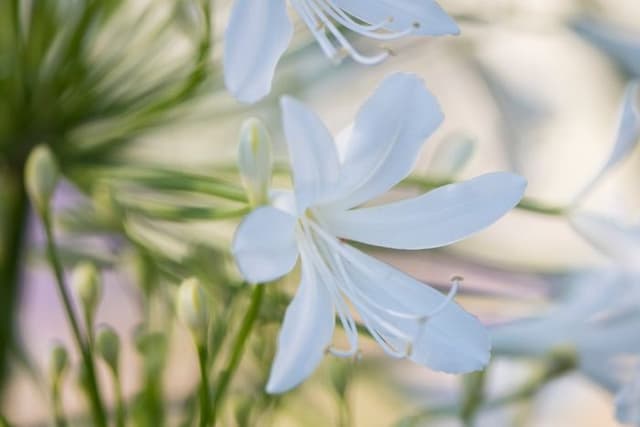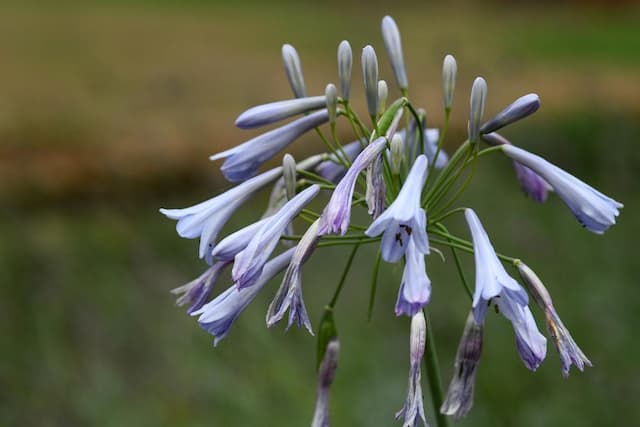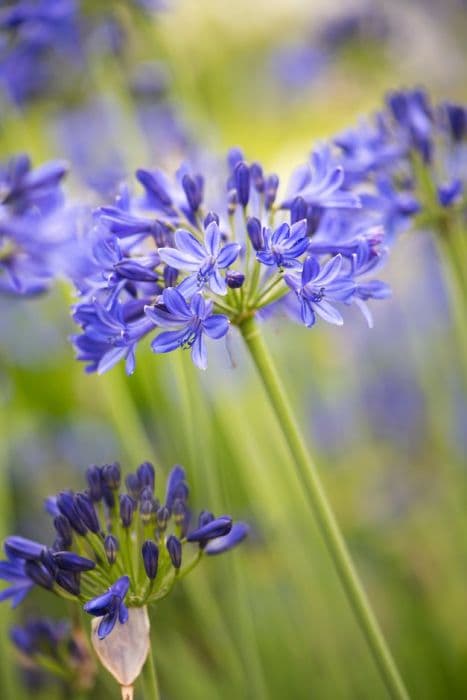African Lily Agapanthus 'Jack's Blue'

ABOUT
Agapanthus 'Jack's Blue', commonly known as Lily of the Nile, is a perennial plant known for its striking floral display and lush foliage. It boasts dense clumps of arching, glossy green leaves that create a lush, strap-like backdrop for the blossoms. The leaves typically emanate from the base of the plant, forming an attractive foundation for the flowers. The true highlights of 'Jack's Blue' are its globular clusters of trumpet-shaped flowers sitting atop sturdy, upright stems. These flowers are a captivating shade of deep blue to violet, sometimes with a hint of lighter blue or white at the petal edges, creating a two-tone effect. The blooms are arranged in a rounded umbel, giving the impression of a single large sphere of individual florets. The overall effect of the Lily of the Nile when in bloom is that of an elegant and vibrant bouquet rising from the clump of foliage, adding a touch of sophistication to gardens or landscapes where it is planted. The contrast between the cool blue tones of the flowers and the warm greens of the leaves can be quite striking and adds significant ornamental value to the plant's surroundings.
About this plant
 Names
NamesFamily
Amaryllidaceae
Synonyms
African Lily, Lily of the Nile
Common names
Agapanthus 'Jack's Blue'
 Toxicity
ToxicityTo humans
African Lily is not considered highly toxic to humans, but it does contain compounds that can cause a mild stomach upset if ingested in large quantities. In such cases, symptoms might include nausea, vomiting, and diarrhea. Care should be taken to prevent accidental ingestion, especially by children who might be attracted to its flowers or berries.
To pets
African Lily is known to be toxic to cats and dogs. If a pet ingests this plant, they may experience symptoms such as nausea, vomiting, diarrhea, abdominal pain, and sometimes excessive salivation or drooling. In severe cases, it can lead to more serious consequences such as tremors or cardiac problems. If you suspect your pet has eaten any part of an African Lily, it is advisable to contact a veterinarian promptly.
 Characteristics
CharacteristicsLife cycle
Perennials
Foliage type
Evergreen
Color of leaves
Green
Flower color
Blue
Height
2 feet [60 cm]
Spread
2 feet [60 cm]
Plant type
Bulb
Hardiness zones
8
Native area
South Africa
Benefits
 General Benefits
General Benefits- Attractive Blooms: Produces striking blue flowers that add a splash of color to any garden.
- Easy to Grow: Known for being a low-maintenance plant that's easy to care for and can thrive in a variety of conditions.
- Drought Tolerant: Once established, it requires little water, making it suitable for xeriscaping and water-wise gardens.
- Long Blooming Period: Flowers in the summer providing a long season of visual interest.
- Clumping Growth: Forms neat clumps that can be used for borders or as a focal point in the garden.
- Cut Flowers: The blooms are ideal for cutting and making beautiful floral arrangements.
- Attracts Wildlife: The flowers can attract pollinators like bees and butterflies, supporting biodiversity.
 Medical Properties
Medical PropertiesThis plant is not used for medical purposes.
 Air-purifying Qualities
Air-purifying QualitiesThis plant is not specifically known for air purifying qualities.
 Other Uses
Other Uses- Photographic backdrop - Agapanthus flowers, with their appealing blue color, can be used as a natural backdrop for outdoor photography, adding a pop of color and a serene feeling to the composition.
- Educational tool - The Agapanthus can be used by teachers to explain plant biology, including topics like pollination and life cycles, due to its distinct and prominent flower structures.
- Landscape architecture - These plants are useful in landscape design to create patterns or border plantings due to their clumping nature and the uniform height of their flower stalks.
- Fabric dye - The blue and purple pigments from Agapanthus flowers may be used as a natural dye for fabrics, although it is not a commonly practiced method.
- Insect habitat - The thick foliage and flowers of Agapanthus can provide a habitat for beneficial insects, supporting biodiversity in gardens.
- Mood enhancer - Being around Agapanthus, with their lush foliage and striking blooms, can improve mental well-being by enhancing the visual appeal of a space and providing a sense of tranquility.
- Pond edging plants - Because they are robust and can tolerate moist conditions, Agapanthus can be used around pond edges to provide structural foliage and a burst of color.
- Art inspiration - The distinctive form and color of Agapanthus flowers can inspire artists and craftsmen, prompting them to create paintings, sculptures, or other art pieces.
- Erosion control - Their thick roots can help stabilize soil in areas prone to erosion, making Agapanthus a practical choice for planting on slopes or in areas where runoff is a concern.
- Seasonal festivals - Agapanthus can be incorporated into seasonal floral arrangements or festival decorations, especially in regions where its blooming season coincides with local events.
Interesting Facts
 Feng Shui
Feng ShuiThe African Lily is not used in Feng Shui practice.
 Zodiac Sign Compitability
Zodiac Sign CompitabilityThe African Lily is not used in astrology practice.
 Plant Symbolism
Plant Symbolism- Love Letters: The genus name "Agapanthus" is derived from the Greek words 'agape', meaning love, and 'anthos', meaning flower, symbolizing love letters or messages.
- Beauty: Agapanthus, with its striking blue flowers, is often associated with beauty and a beautiful sight to behold in any garden.
- Endurance and Survival: These plants are known for their hardiness and ability to survive in tough conditions, representing strength, endurance, and survival.
- Fertility: Its lush growth and abundant flowering can symbolize fertility and the creation of new life.
- Home and Hearth: Often found adorning gardens and patios, the Agapanthus can represent protection of home and a welcoming environment.
- Friendship: The plant's easy-growing nature and its role in adorning spaces can also symbolize the nurturing of friendships and relationships.
 Water
WaterFor the Lily of the Nile, water it thoroughly when the top inch of the soil feels dry to the touch. Generally, this means once every week during the growing season; however, the frequency may need to increase to twice a week during hot, dry periods. In cooler months or when the plant is dormant, reduce watering to every couple of weeks. Ensure that each watering deeply saturates the soil to encourage deep root growth. Typically, using about one gallon of water per plant will suffice for each watering session, but make sure not to overwater as Lily of the Nile does not like to sit in waterlogged soil.
 Light
LightThe Lily of the Nile thrives best in full sunlight to partial shade. A spot that receives at least six hours of direct sunlight is ideal for robust growth and optimal blooming. However, in very hot climates, the plant will appreciate some afternoon shade to protect it from the intense heat of the day.
 Temperature
TemperatureLily of the Nile prefers a temperature range between 50 and 90 degrees Fahrenheit for optimal growth. It can survive temperature dips down to around 20 degrees Fahrenheit but could be damaged by temperatures lower than this. Providing a location that avoids extreme cold is vital, especially in the winter months.
 Pruning
PruningPruning the Lily of the Nile promotes healthier growth and more abundant blooms. Remove spent flower stalks after blooming, and cut back the foliage if it becomes unsightly, generally towards the end of winter or early spring. This annual pruning will help revitalize the plant for the upcoming growing season.
 Cleaning
CleaningAs needed
 Soil
SoilLily of the Nile thrives in fertile, well-draining soil mixed with compost or peat for added nutrients. A soil pH of 6 to 7 is ideal to encourage healthy growth and flowering.
 Repotting
RepottingLily of the Nile should be repotted every 2 to 3 years to refresh the soil and provide room for expansion, especially when it becomes root-bound.
 Humidity & Misting
Humidity & MistingLily of the Nile can tolerate a wide range of humidity levels, but it performs best in moderate to high humidity environments without requiring specific humidity adjustments.
 Suitable locations
Suitable locationsIndoor
Ensure bright light, well-draining soil, and room for growth.
Outdoor
Plant in full sun to partial shade, well-draining soil.
Hardiness zone
8-10 USDA
 Life cycle
Life cycleThe life cycle of the Agapanthus 'Jack's Blue', commonly known as the African Lily, begins with seed germination, where the seeds must be sown in well-draining soil and kept warm to encourage sprouting. After emergence, the seedling stage involves developing a small rosette of strap-shaped leaves and establishing a root system. As it enters the vegetative growth phase, it focuses on leaf production and building a stronger root network to support the plant. The next stage is the flowering phase, during which the African Lily produces tall stalks topped with clusters of trumpet-shaped, blue flowers, typically in the summer. After pollination, if successful, the flowers are followed by the development of seed pods that ripen and eventually release seeds, completing the reproductive cycle. Lastly, the plant enters a period of dormancy in the colder months, where growth slows down significantly until conditions become favorable again in the following growing season.
 Propogation
PropogationPropogation time
Spring-Early Summer
When it comes to propagating the Agapanthus 'Jack's Blue', also commonly known as Lily of the Nile, the most popular method is through division. The best time for this is in the spring or early fall when the plant is not in active bloom. Division involves carefully digging up the Agapanthus clump and using a sharp spade or knife to separate it into smaller sections, ensuring that each new division has a portion of roots attached. These sections can then be replanted at the same depth they were growing previously. The soil should be well-drained, and the divisions should be watered thoroughly after planting to encourage establishment. It's important not to divide too often, as Agapanthus plants bloom best when their roots are somewhat crowded.







![African lily [Brilliant Blue]](/_next/image?url=https%3A%2F%2Fplants-admin.emdemapps.com%2Fimages%2Fplants%2F%2Fimages%2F604b5e3c28e2b.png&w=640&q=75)

